A history of Grand Seiko in ten chapters. Vol.3 The pursuit of ultimate precision in a mechanical movement
EVOLUTION The Grand Seiko tradition of dedication to precision, the ultimate goal of watchmaking.
Every watch is judged, above all else, by its precision. Right from the very start, this truth has inspired the development of Grand Seiko. The standard of accuracy for Grand Seiko in the mid 1960’s was +5 to -3 seconds per day. To put this in perspective, please think of it in relation to the 86,400 seconds that constitute every day; a 1960’s Grand Seiko was accurate to at least 1/10,000th of this number. This extraordinary level of precision in a mechanical watch required superb design, parts that were manufactured to the very highest standards and assembled and adjusted to near perfection.
At that time, many watch manufacturers participated in precision contests held by observatories and other testing bodies, to further advance their technologies and gain recognition of their watchmaking expertise. In the late 1950’s, Seiko had participated in, and won, all the accuracy competitions in Japan so looked to the international stage for its next challenge. From 1964, Seiko participated in the mechanical wristwatch division of the competitions held in Switzerland. Suwa Seikosha (former name of Seiko Epson) and Daini Seikosha (former name of Seiko Instruments) each developed movements for these trials and Seiko entered them in these most prestigious of competitions.
Movements developed for these trials differed from those used in the watches then on sale, with special specifications for both the materials used and the design. One essential technology was the high beat movement. The higher the beat rate, the less is the movement's susceptibility to outside impact, allowing the timepiece to maintain its high precision. Grand Seiko’s production movements were 5 to 5.5 beat at that time, but the watches entered in the competitions were mainly 10 beat movements because Seiko hoped to incorporate the high precision expertise gained through participation in these competitions in the watches that would be subsequently made. Making this a reality, however, was not an easy task. To move parts at a higher speed requires a mainspring with high torque. Moreover, a high performance lubricating oil is essential and a high level of processing precision is needed for the components as well. To incorporate these elements in a watch suitable for daily use posed an enormous challenge, but the team decided that, in order to make Grand Seiko one of the very finest watches in the world, the required effort, expense and investment of resources was well worth it.
EVOLUTION The Grand Seiko tradition of dedication to precision, the ultimate goal of watchmaking.
Every watch is judged, above all else, by its precision. Right from the very start, this truth has inspired the development of Grand Seiko. The standard of accuracy for Grand Seiko in the mid 1960’s was +5 to -3 seconds per day. To put this in perspective, please think of it in relation to the 86,400 seconds that constitute every day; a 1960’s Grand Seiko was accurate to at least 1/10,000th of this number. This extraordinary level of precision in a mechanical watch required superb design, parts that were manufactured to the very highest standards and assembled and adjusted to near perfection.
At that time, many watch manufacturers participated in precision contests held by observatories and other testing bodies, to further advance their technologies and gain recognition of their watchmaking expertise. In the late 1950’s, Seiko had participated in, and won, all the accuracy competitions in Japan so looked to the international stage for its next challenge. From 1964, Seiko participated in the mechanical wristwatch division of the competitions held in Switzerland. Suwa Seikosha (former name of Seiko Epson) and Daini Seikosha (former name of Seiko Instruments) each developed movements for these trials and Seiko entered them in these most prestigious of competitions.
Movements developed for these trials differed from those used in the watches then on sale, with special specifications for both the materials used and the design. One essential technology was the high beat movement. The higher the beat rate, the less is the movement's susceptibility to outside impact, allowing the timepiece to maintain its high precision. Grand Seiko’s production movements were 5 to 5.5 beat at that time, but the watches entered in the competitions were mainly 10 beat movements because Seiko hoped to incorporate the high precision expertise gained through participation in these competitions in the watches that would be subsequently made. Making this a reality, however, was not an easy task. To move parts at a higher speed requires a mainspring with high torque. Moreover, a high performance lubricating oil is essential and a high level of processing precision is needed for the components as well. To incorporate these elements in a watch suitable for daily use posed an enormous challenge, but the team decided that, in order to make Grand Seiko one of the very finest watches in the world, the required effort, expense and investment of resources was well worth it.
Read More
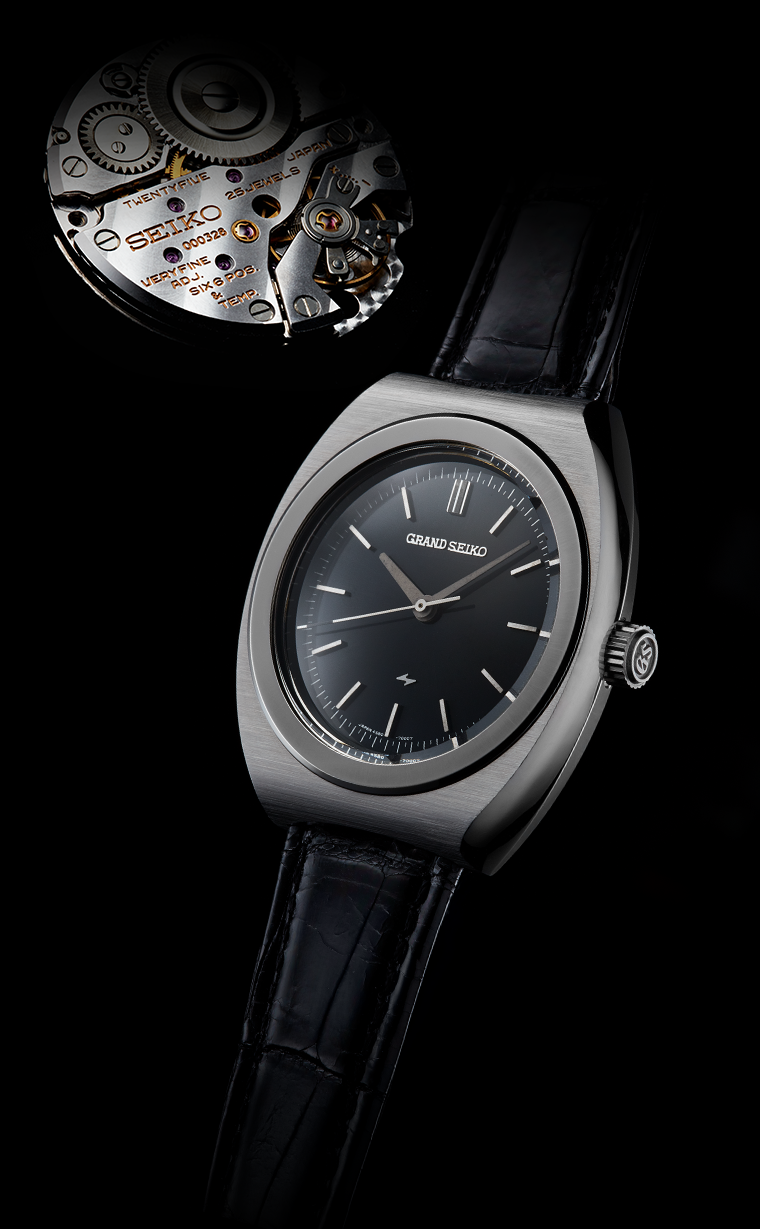
Daini Seikosha's V.F.A. model, born in 1969, was fitted with a manual winding movement, Caliber 4580. At the 12 o'clock position on the dial is the GRAND SEIKO logo. It is a masterpiece that expresses the strong determination of the Grand Seiko engineers to challenge the limits of high-precision mechanical watchmaking.
Neuchatel Observatory Chronometer contests and qualification
1967 Neuchatel Observatory Chronometer contest Caliber 052 Caliber 052 used by Daini Seikosha in the Neuchatel Observatory Chronometer contests in 1966 and 1967. In order to avoid the hairspring becoming magnetized during the flight from Tokyo to Europe, an anti-magnetic case made of permalloy was used. The bridge-shaped balance cock is also a characteristic feature.
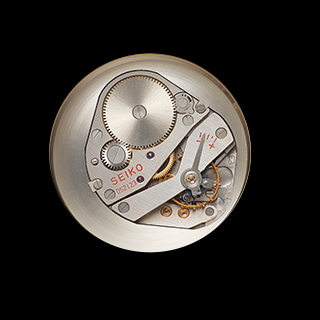
1969 Neuchatel Observatory Chronometer-certified watch
An actual ‘Observatory Chronometer Certified’ watch that passed the chronometer inspection at the Neuchatel Observatory. All of the 73 watches that were granted certification by the Neuchatel Observatory in 1968 were sold in 1969.
(Photo is from a personal collection. The 18k gold bracelet with the same finish as the case is a separate item.)
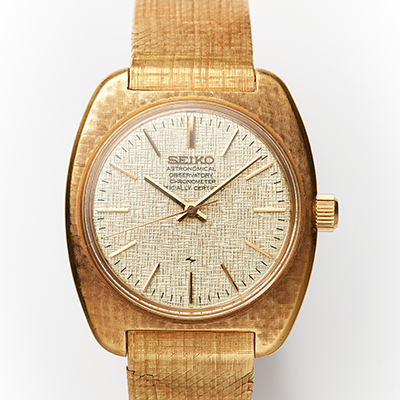
1967 Neuchatel Observatory Chronometer contest Caliber 052
Caliber 052 used by Daini Seikosha in the Neuchatel Observatory Chronometer contests in 1966 and 1967. In order to avoid the hairspring becoming magnetized during the flight from Tokyo to Europe, an anti-magnetic case made of permalloy was used. The bridge-shaped balance cock is also a characteristic feature.
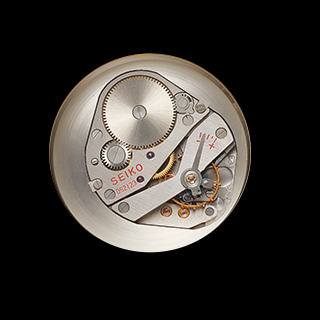
1969 Neuchatel Observatory Chronometer-certified watch
An actual ‘Observatory Chronometer Certified’ watch that passed the chronometer inspection at the Neuchatel Observatory. All of the 73 watches that were granted certification by the Neuchatel Observatory in 1968 were sold in 1969.
(Photo is from a personal collection. The 18k gold bracelet with the same finish as the case is a separate item.)
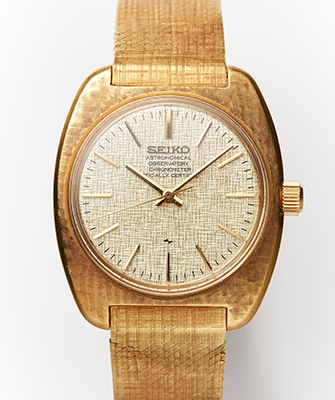
Turning a highly accurate high-beat movement into a practical timepiece.
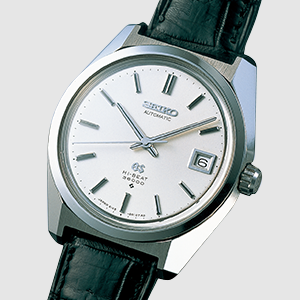
61GS, 1968 This automatic winding 10-beat movement, Caliber 6145, was manufactured by Suwa Seikosha, using the techniques developed during the period of participation in the observatory contests. This model, released in early 1968, was designed with the focus on everyday practicality, with a calendar at the 3 o'clock position.
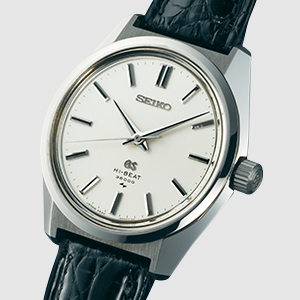
45GS, 1968 This watch was known as 45GS. It was fitted with a manual winding 10-beat movement, Caliber 4520, manufactured by Daini Seikosha, and launched in 1968. Models carrying Caliber 4522 with a calendar, also had an instantaneous date change feature.
